Physical Address
304 North Cardinal St.
Dorchester Center, MA 02124
Echocardiography has broad utility in the diagnosis and management of cardiovascular disease. Echocardiography allows for real-time, precise anatomic definition and physiologic interrogation of cardiac and vascular structures at relatively low cost with minimal patient risk and discomfort. Common clinical applications for echocardiography include assessment of myocardial and valvular function, identification of structural abnormalities, and optimizing timing for surgical intervention. Echocardiography has expanded beyond the diagnostic laboratory to include the intensive care unit, emergency department, operating room, and electrophysiology and cardiac catheterization laboratories. This chapter will briefly review the basic principles of ultrasound imaging, echocardiographic approaches, and clinical applications of echocardiography ( Table 55-1 ).
| Diagnosis | Key Echocardiographic Findings | Limitations of Echocardiography |
|---|---|---|
| Cardiomyopathy | ||
| LV size, wall thickness, and systolic function RV size and function PA pressure estimate Valvular anatomy and dysfunction |
||
| Valvular Heart Disease | ||
| Valve stenosis | Etiology and severity of stenosis LV and RV size and systolic function PA pressure estimate |
May underestimate stenosis severity |
| Valve regurgitation | Mechanism and etiology of regurgitation Severity of regurgitation PA pressure estimate |
TEE and 3D imaging may be needed to evaluate MR and valve anatomy |
| Prosthetic valves | Evidence for stenosis or regurgitation PA pressure estimate |
Imaging prosthetic valves limited by artifact TEE needed for suspected prosthetic MR |
| Endocarditis | Detection of vegetations, abscess Presence, degree of valve dysfunction |
TEE increases sensitivity for detecting vegetations and abscess |
| Coronary Artery Disease | ||
| Acute MI | Segmental wall motion abnormality reflects “myocardium at risk” | Coronary artery anatomy not directly visualized |
| Global LV function (EF) Evaluate for MI complications |
||
| Angina | Global and segmental LV function Exclude other causes of angina (e.g., AS, HOCM) |
Resting wall motion may be normal despite significant CAD Stress echocardiography needed to induce ischemia |
| End-stage ischemic disease | Global and segmental LV function RV function, PA pressures |
|
| Pericardial Disease | ||
| Pericardial thickening Detection, size, location of pericardial fluid Signs of tamponade physiology |
Tamponade is a hemodynamic and clinical diagnosis (blood pressure, heart rate) | |
| Aortic Disease | ||
| Aortic root dilation | Etiology of aortic dilation Accurate aortic diameter measurements Associated aortic regurgitation |
|
| Aortic dissection | Accurate aortic diameter measurements Imaging of dissection “flap” (dissection) Associated aortic regurgitation |
TEE more sensitive and specific Cannot assess distal vascular beds |
| Cardiac Masses | ||
| LV/LA thrombus | TTE has high sensitivity and specificity for LV thrombus | TEE is needed to detect LA thrombus reliably |
| Cardiac tumors | Size, location, and physiologic consequences of tumor mass | Extracardiac involvement not well seen Cannot distinguish benign from malignant, or tumor from thrombus |
| Pulmonary HTN | ||
| RV size and systolic function PA pressure estimate |
||
| Congenital Heart Disease | ||
| Detection of anatomic abnormalities Quantitation of physiologic abnormalities LV and RV size and systolic function |
No direct intracardiac pressure measurements Saline contrast may be needed to assess intracardiac shunts |
|
Echocardiographic images are generated from analyses of reflected ultrasound waves from piezoelectric crystals. Ultrasound waves are beyond audible sound wave range (>20 kHz). Ultrasound waves reflect off internal structures, such as the heart and vasculature, and they are reflected back to the transducer. Analysis of the intensity and timing of these reflected sound waves allow for image generation. Propagation of ultrasound waves is optimal through liquid medium (blood). In contrast, air and bone cause significant acoustic impedance, resulting in poor ultrasound penetration. Therefore, suboptimal image generation occurs with intervening structures such as ribs or surface bandages, or if images are acquired through air-filled lungs or subcutaneous air. Factors that affect ultrasound propagation will affect image quality, such as ultrasound beam refraction, beam attenuation due to absorption of ultrasound energy by tissue, and disarrayed beam reflection or scatter.
Echocardiographic examinations include the use of several ultrasound modalities, including M-mode, two-dimensional imaging, color flow imaging, and spectral Doppler imaging, with continuous-wave and pulsed Doppler ultrasound. Because images are generated from reflected signals, they are not truly “real-time,” but image processing is rapid, making the time differential indiscernible. Two-dimensional (2D) echocardiography displays images using a simultaneous ultrasound array across a tomographic plane at a frame rate of 50 to 60 frames/second. Transthoracic echocardiography uses transducer positions that provide acoustic access to the heart: parasternal, apical, subcostal, and suprasternal ( Fig. 55-1 ). From these “windows,” tomographic image planes are aligned with respect to the cardiac anatomy in long-axis, short-axis, and apical four-chamber and two-chamber views ( Fig. 55-2 ). Acoustic shadowing from structures that block ultrasound wave propagation, such as prosthetic valves or calcification, will block imaging distal to the structure. For example, a mechanical mitral prosthesis imaged from a transthoracic window creates acoustic shadowing of the left atrium and an inability to evaluate regurgitation severity ( Fig. 55-3 ). Although most diagnostic echocardiography requires full ultrasound systems, smaller, handheld devices are increasingly available for portable, bedside diagnostic testing in intensive care units, emergency departments, and similar clinical settings. Recognition of ultrasound image artifacts is essential to identify abnormal findings correctly. Common artifacts include reverberations, beam width artifacts, and beam refraction, as well as external artifacts from electronic effects on the ultrasound machine, such as electrocautery during imaging.
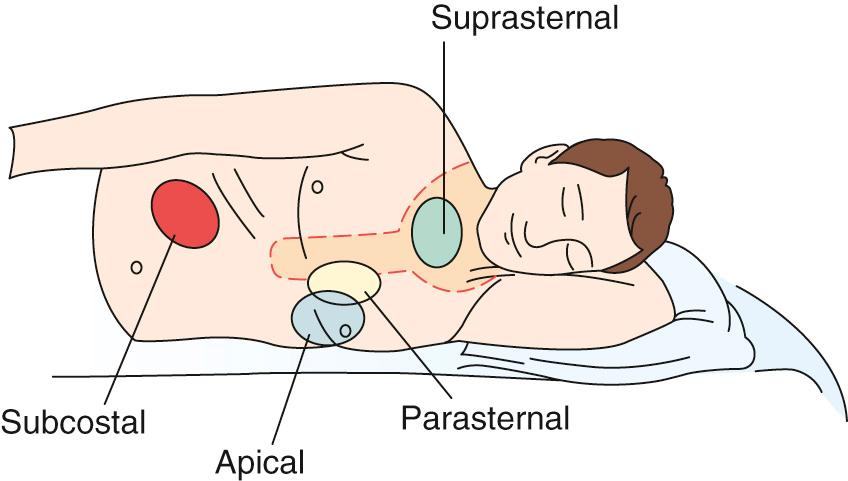
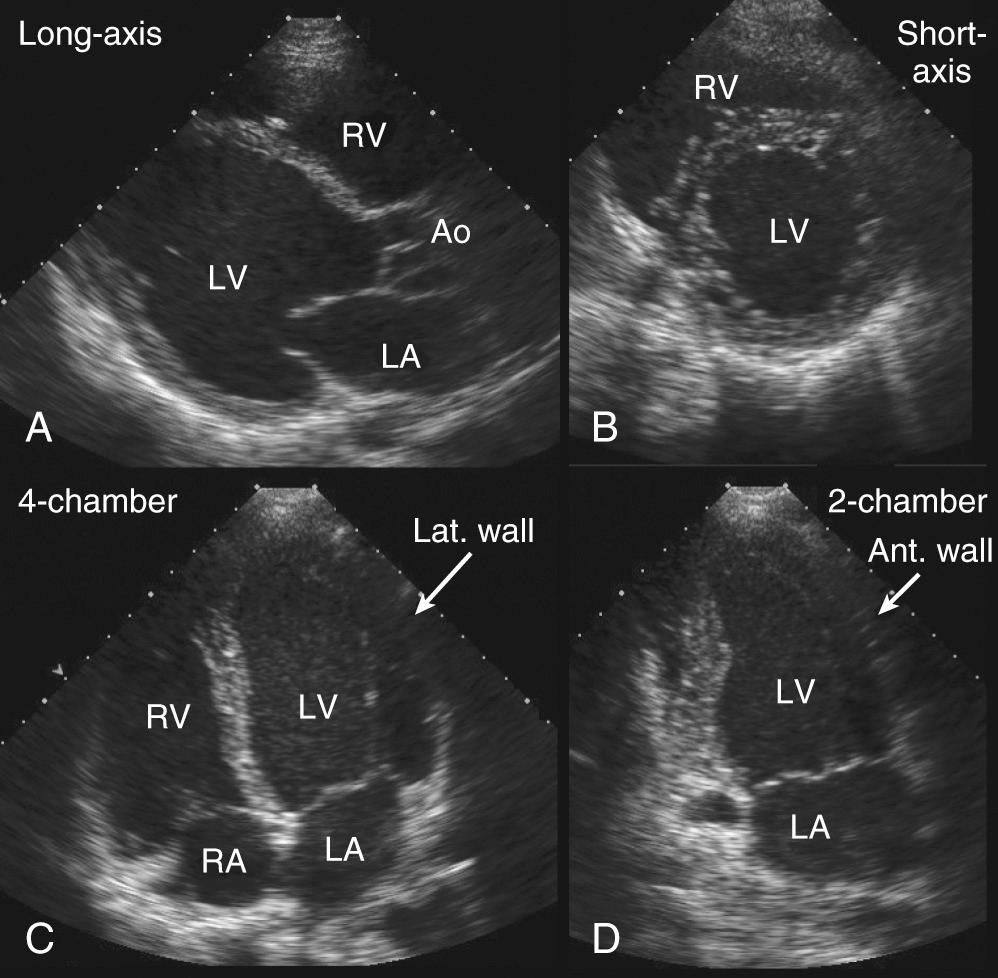
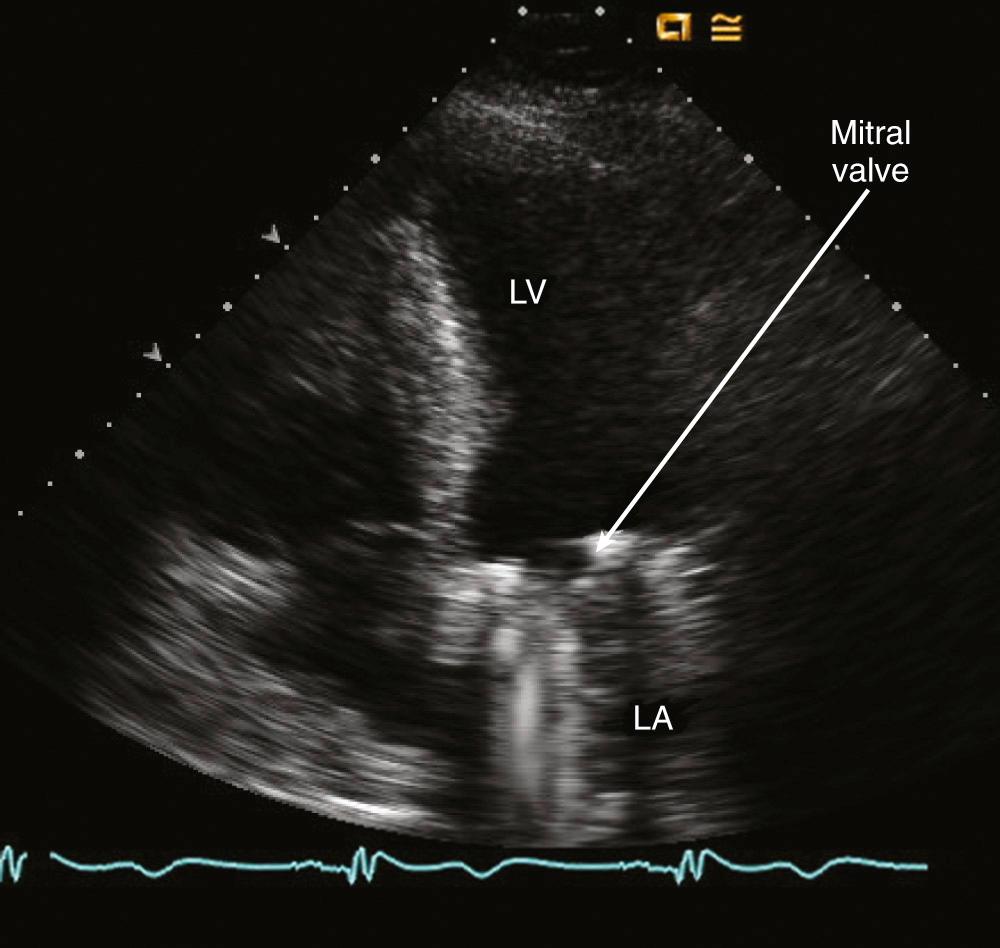
M-mode (motion) echocardiography is produced by displaying reflected signals received from an ultrasound beam against the time dimension ( Fig. 55-4 ). Because data from a single ultrasound beam are used, temporal (timing) resolution for M-mode is excellent, with an imaging frame rate greater than 1800 frames per second. M-mode is useful for measurement of cardiac dimensions, for timing of events such as valve opening and closing, and for demonstrating rapid, fine motion such as fluttering of the anterior mitral valve leaflet with aortic regurgitation or independent mobility of valvular vegetations.
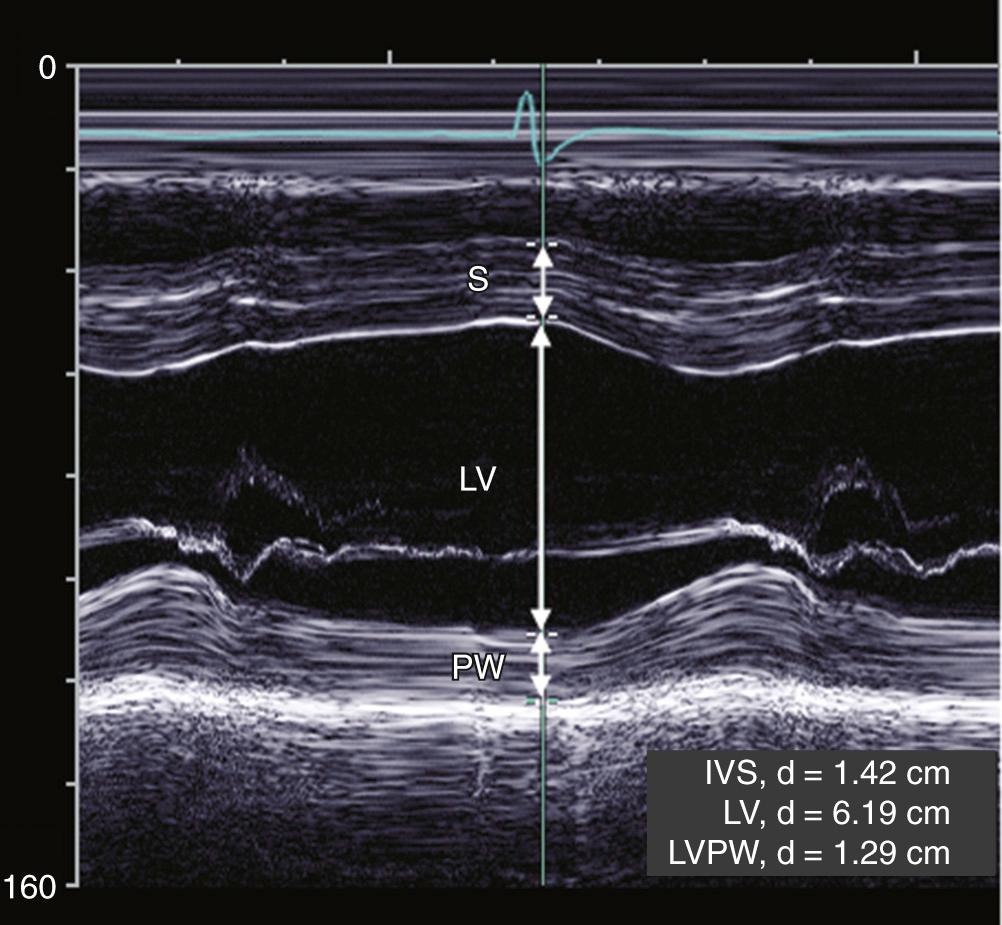
Transesophageal echocardiography (TEE) is a semi-invasive procedure in which the transducer is mounted on a flexible endoscope and positioned in the esophagus and stomach. Manipulation of the TEE probe is constrained by esophageal anatomy, and oblique image planes can hinder acquisition of standard images. However, image resolution for TEE is significantly improved over transthoracic echocardiography (TTE) because of the lack of intervening air or bone. Transesophageal imaging allows for better visualization of posterior cardiac structures, such as the mitral valve, left atrium, left atrial appendage, interatrial septum, and thoracic aorta. TEE is more accurate than TTE for identifying valvular vegetations and complications of endocarditis, aortic pathology, and mitral valve abnormalities. TEE is used to identify left atrial thrombus as a potential cardiac source of distal embolic disease and to exclude thrombus presence before direct current cardioversion for atrial fibrillation ( Fig. 55-5 ). In the intensive care unit, TEE has been used in determining the etiology of unexplained hypotension, and it is helpful in evaluating patients after cardiac surgery at increased risk for ischemia, hypovolemia, and pericardial tamponade. However, TEE usually requires conscious sedation to reduce patient discomfort, with additional monitoring and nursing support.
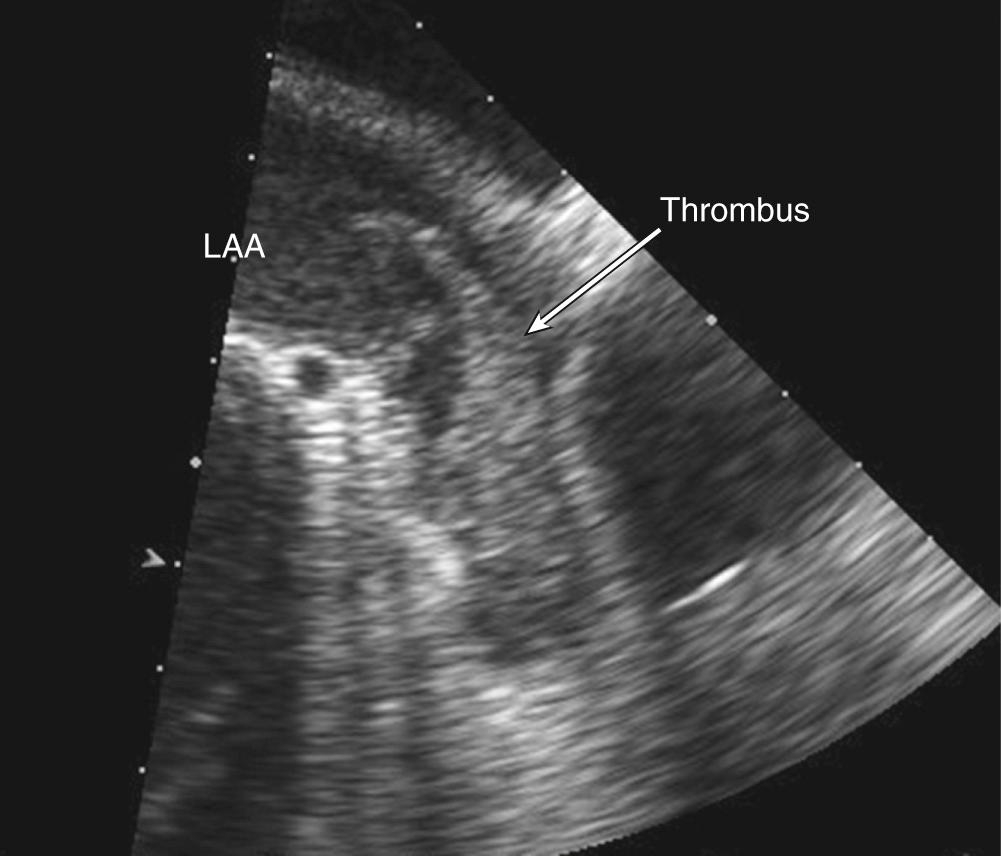
Three-dimensional (3D) echocardiographic images display cardiac anatomy using a simultaneous ultrasound array across a pyramidal volume. Image processing from the large data set decreases the imaging frame rate even lower than 2D imaging, but spatial resolution is further improved. Both transthoracic and transesophageal 3D imaging transducers are available. Image processing of 3D volume data sets can systematically “cut away” portions of the volume to provide two-dimensional image planes analogous to standard long-axis, short-axis, and four-chamber views. Intraprocedural 3D TEE imaging is increasingly being used to aid operators, such as in aortic annulus cross-sectional area sizing for transcatheter aortic valve placement, percutaneous closure device placement, and procedural success of mitral balloon valvuloplasty ( Fig. 55-6 ).
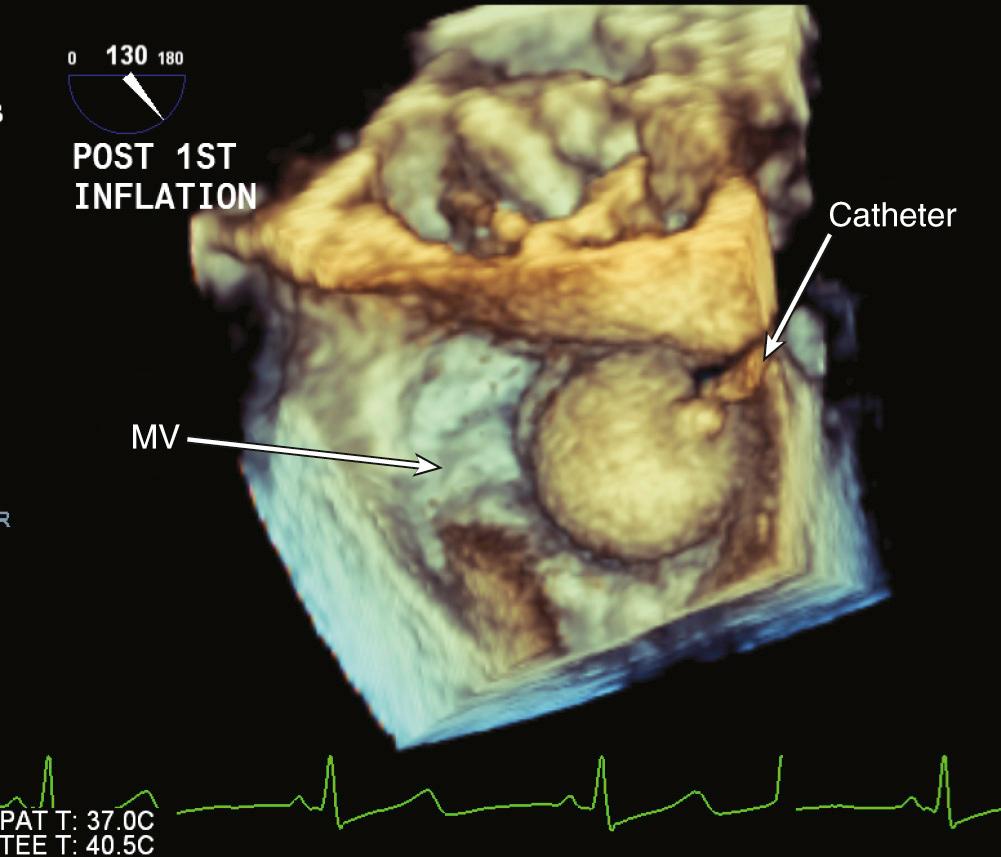
Contrast echocardiography is performed in conjunction with echocardiography to opacify cardiac chambers. Contrast agents include intravenous agitated saline to opacify the right heart chambers for detection of intracardiac shunts ( Fig. 55-7 ), and commercially made microbubble agents that traverse the pulmonary bed to provide left heart opacification. Opacification of the left-sided cardiac chambers enhances endocardial border definition to aid in wall motion analysis when image quality is suboptimal ( Fig. 55-8 ). Although microbubble transpulmonary contrast can provide information on myocardial perfusion, this methodology is still in development.
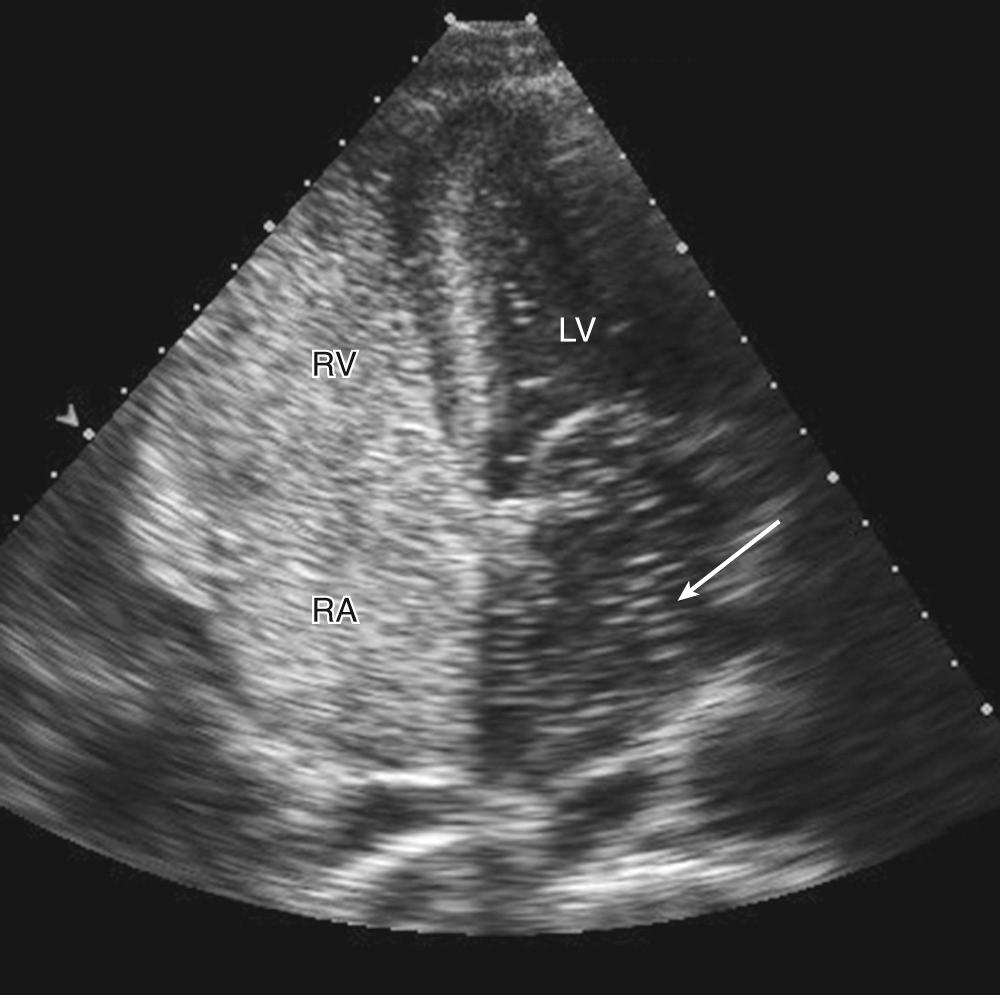
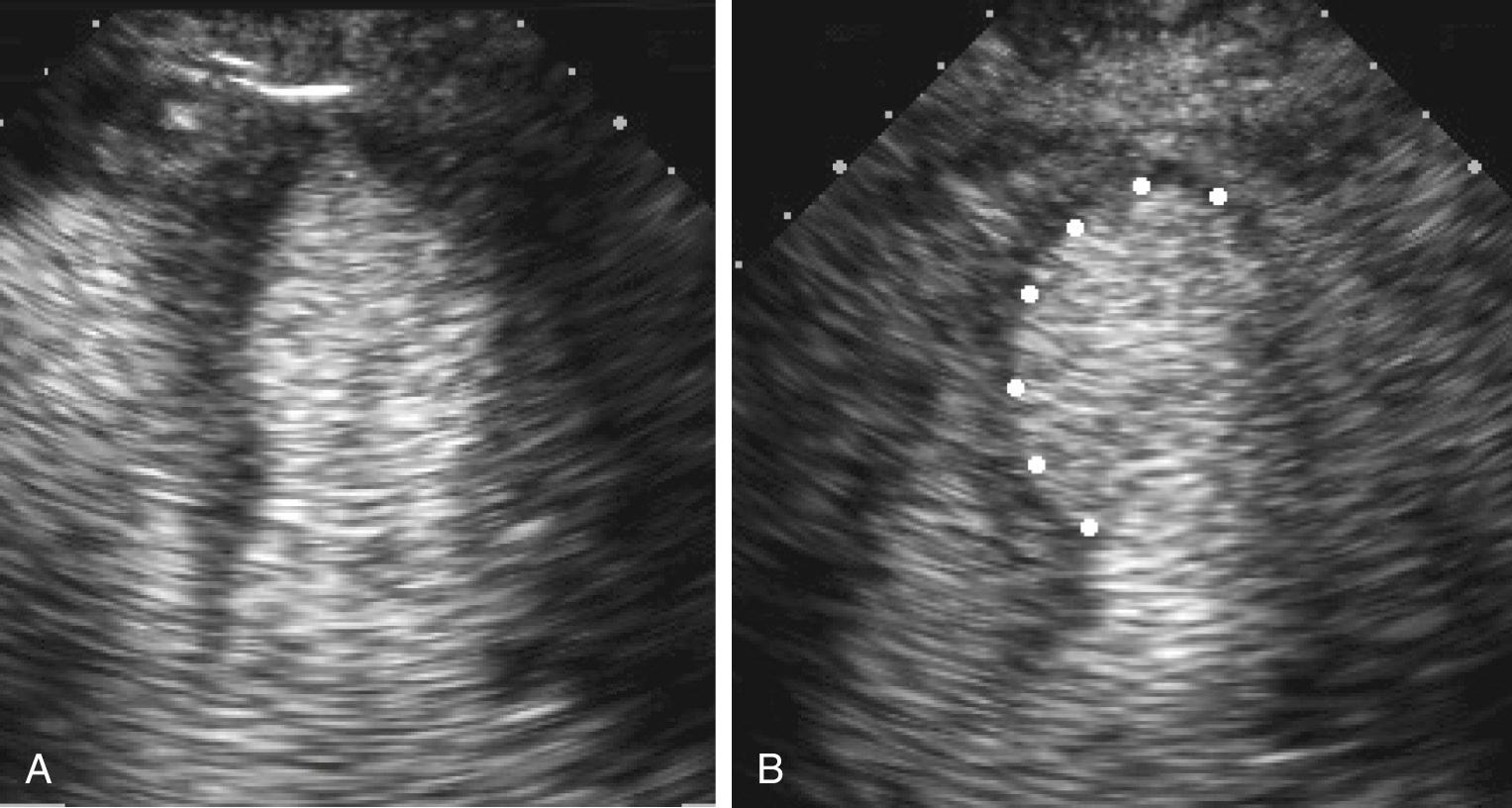
Epicardial intraoperative echocardiography is performed by placing the transducer directly on the heart during cardiac surgery. This modality is used when anterior structures are suboptimally seen with a transesophageal approach. In intravascular ultrasound, imaging is performed via a percutaneously placed intravascular catheter. The most common use of this technique is intracoronary transducer placement to assist in plaque characterization and assessment of stenosis severity and intracardiac transducers used in the catheterization and electrophysiology laboratories for periprocedural aid in catheter placement.
Doppler echocardiography provides information on the direction and velocity of blood flow. Reflected frequencies from an object moving toward a sound source are higher than the original signal, and are lower from an object moving away from the sound source. Doppler echocardiography measures Doppler shift in the reflected signals from moving red blood cells. By convention, frequency shifts toward the transducer are shown above the zero baseline, and shifts away from the transducer are shown below the baseline. Importantly, detecting maximum velocity relies on parallel alignment of the ultrasound beam with the direction of blood flow, and a nonparallel intercept angle will result in erroneous data with underestimation of maximum velocity.
With pulsed wave Doppler (PWD), the transducer alternates between sending and receiving signals, sampling blood velocities at a specified depth along the ultrasound beam. There is a limited measurable maximal velocity with PWD (the “Nyquist limit”) beyond which the signal aliases and peak velocity cannot be accurately measured. With continuous wave Doppler (CWD), the transducer continuously transmits and receives signals along the entire length of the ultrasound beam. Although the specific depth origin of the CWD velocity cannot be localized, signal aliasing does not occur, and higher blood velocities, such as seen in stenotic valves, can be measured.
PWD and continuous wave Doppler (CWD) velocity data are displayed as a graph of velocity versus time, with signal strength displayed using a decibel grey scale. By convention, frequency shifts toward the transducer are shown above the baseline. The velocity time integral (VTI) is the integral of blood flow velocity over time, measured in distance. The shape, timing, and density of spectral Doppler images provide valuable qualitative evaluation of blood flow, and increased jet density suggests increased flow volume. Rapid equalization of pressure gradients between two cardiac chambers leads to steeper jet slopes ( Fig. 55-9 ). Color Doppler echocardiography is an application of pulsed Doppler imaging in which data from multiple PWD samples across a 2D imaging sector are combined and velocities are mapped onto a color scale. These color maps are then superimposed onto a 2D image, providing directional blood flow information. By convention, flow toward the transducer is displayed in red and flow away is displayed in blue, with the color transition occurring at the Nyquist limit. Color Doppler echocardiography is used for qualitative evaluation of valve regurgitation by examining the timing and extent of flow disturbance created by the regurgitant jet. Severity is usually rated on a scale of 1+ (mild) to 4+ (severe).
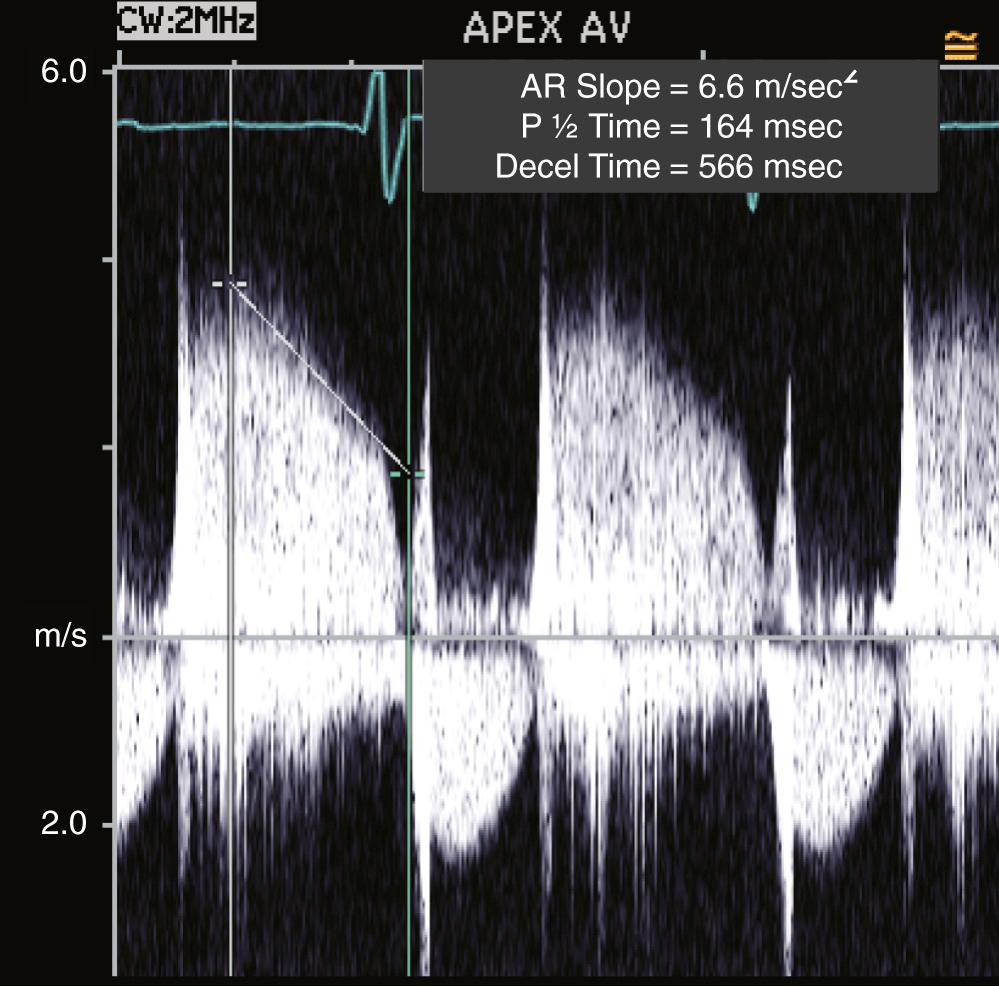
Doppler echocardiography is invaluable for evaluation of valve regurgitation. Color Doppler mapping aids in visualization of the jet origin and direction. Measurement of the narrowest jet width on color Doppler imaging (vena contracta) at or just distal to the regurgitant orifice is a simple measure that correlates with regurgitation severity ( Fig. 55-10 ). Accuracy in measuring the vena contracta is crucial because small errors lead to inaccurate assessment of regurgitation severity. Other qualitative markers of regurgitation severity include flow reversal of the Doppler signal in adjacent upstream vascular structures, seen when regurgitation severity is moderate or greater.
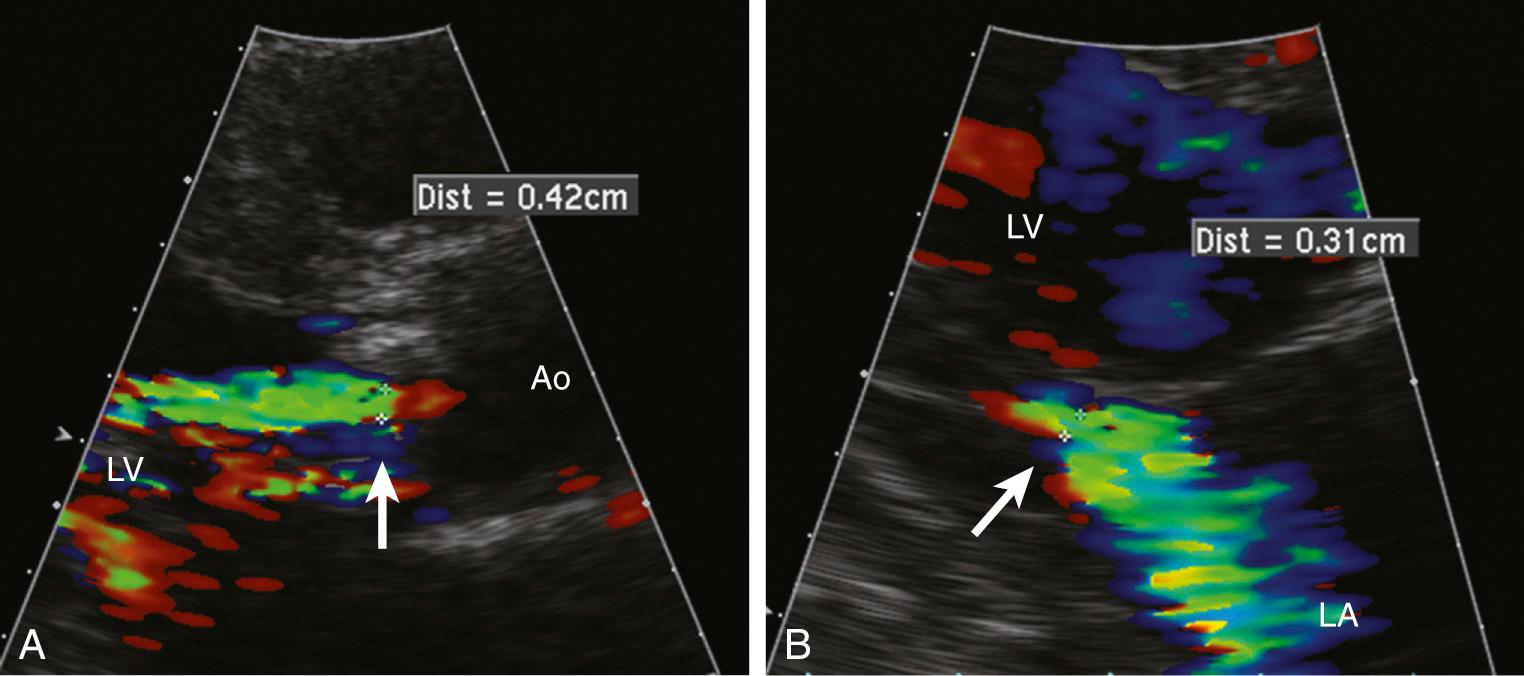
When combined with qualitative measures, Doppler echocardiography allows for hemodynamic assessment, such as quantitation of valve stenosis and regurgitation severity, cardiac stroke volume, ventricular systolic and diastolic function, and intracardiac pressure calculation. There are three primary Doppler principles used in clinical practice: (1) flow quantitation (stroke volume calculation), (2) continuity of flow, and (3) pressure/velocity (Bernoulli's equation). The stroke volume (SV) traversing a cardiac orifice is the product of the cross-sectional area (CSA) at that point and the velocity time integral (VTI FLOW ).
Cross-sectional area, assuming a circular orifice, is calculated by measuring the diameter at the point of interest (Area = π r 2 ). The velocity time integral is obtained from spectral Doppler interrogation. The principle of continuity of flow describes the concept that the stroke volume passing just proximal to an orifice (SV pre ) is the same as the stroke volume passing through the orifice (SV orifice ). The most common application of the continuity equation is in aortic valve area measurement for stenosis where the stroke volume (SV pre ) is measured at the left ventricular outflow tract, discussed in further detail in the valve stenosis portion of this chapter. The principle of continuity of flow is also used for the calculation of regurgitant orifice size and volumes using the flow convergence proximal to the regurgitant valve proximal isovelocity surface area [PISA]). The PISA method uses the principle that blood accelerates in a laminar fashion toward a regurgitant orifice, forming multiple “hemispheres” of isovelocity ( Fig. 55-11 ). Effective regurgitant orifice size (EROA) can then be calculated from flow velocities.
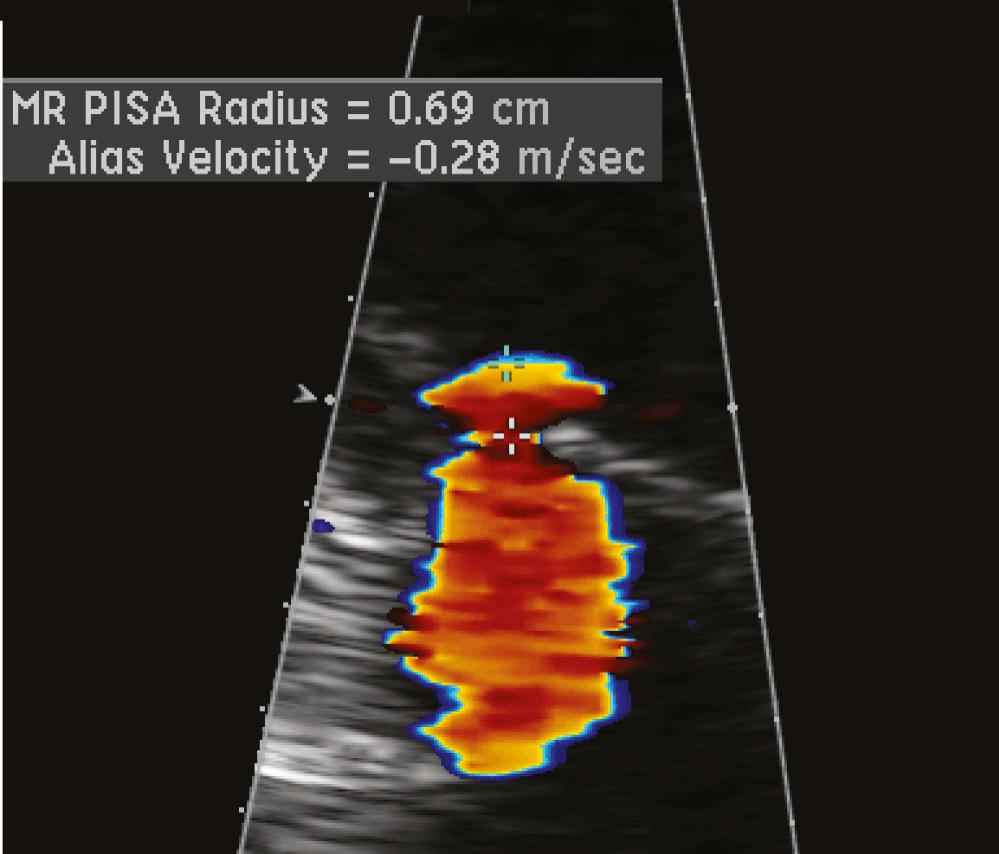
When a blood flow stream narrows, (i.e., when traversing a valve orifice), flow velocity (v) increases in proportion to the degree of narrowing. Increases in velocity are correlated with increased pressure gradients across the orifice, and this is described by the Bernoulli equation (pressure–velocity relationship). Ignoring the effects of viscous loss and local red blood cell acceleration, the relationship is simplified to:
Estimation of transvalvular pressure gradients is a common application of the Bernoulli equation ( Fig. 55-12 ). Another common application is the estimation of pulmonary arterial pressures. The pressure gradient between the right ventricle and right atrium is calculated using the systolic velocity from the tricuspid regurgitant jet ( Fig. 55-13 ). In the absence of pulmonary stenosis, pulmonary arterial systolic pressure is equal to the sum of right ventricular (RV) systolic pressure and right atrial pressure. Right atrial pressure is obtained by examining inferior vena cava (IVC) diameter at rest and with inspiration, measured before the junction to the right atrium ( Fig. 55-14 and Table 55-2 ). Measurement of pulmonary arterial systolic pressure is widely applicable as 90% of individuals have some degree of tricuspid regurgitation.
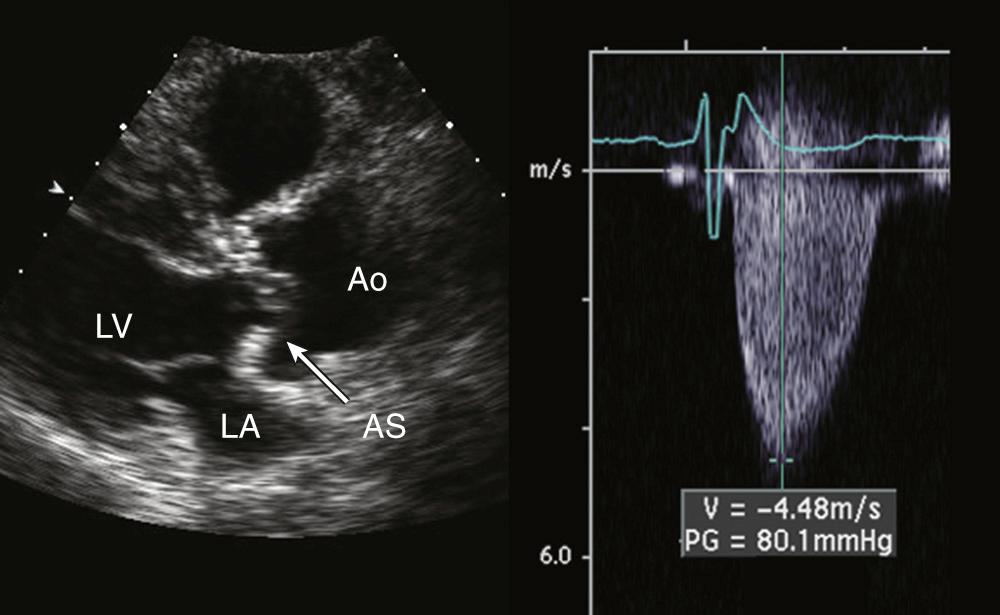
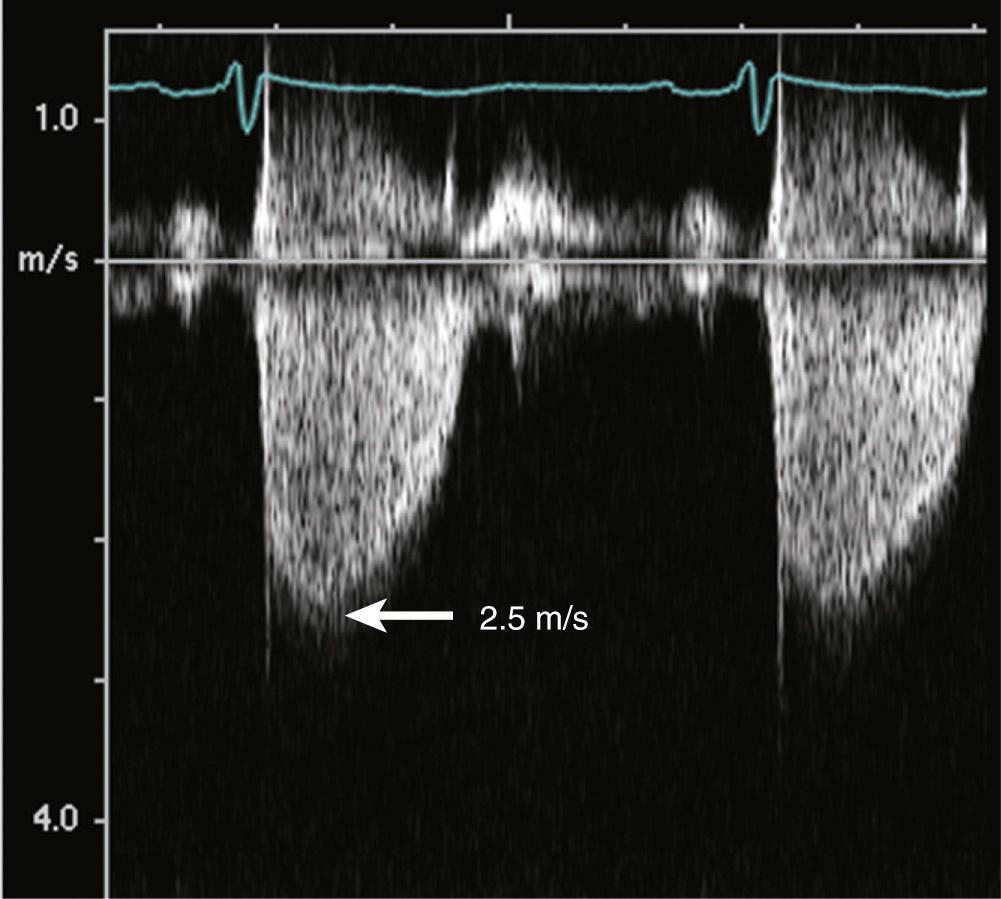
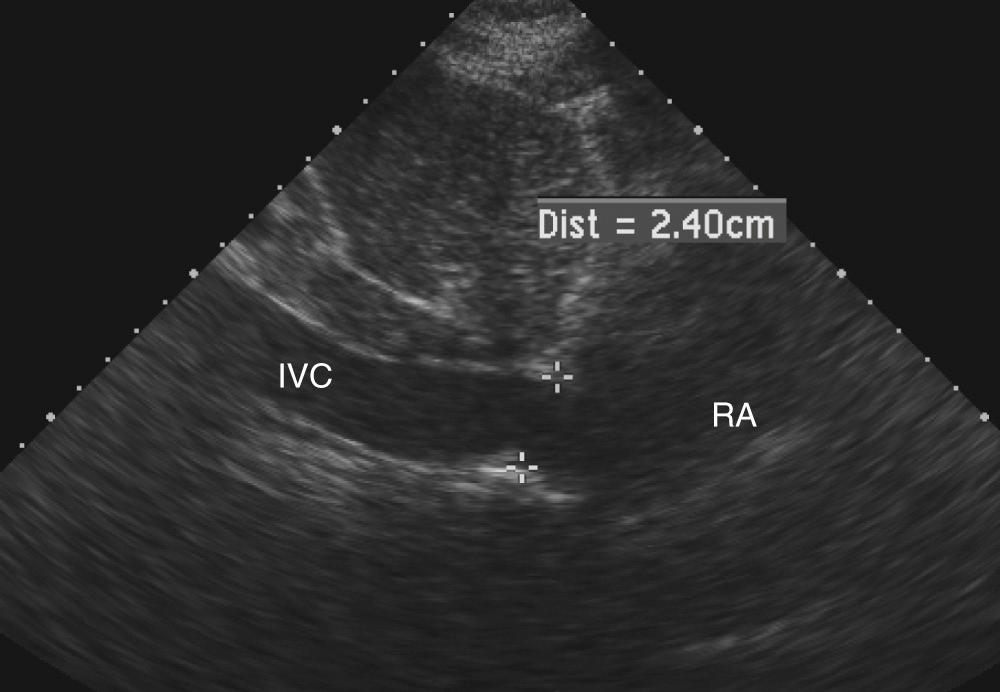
| Inferior Vena Cava Diameter | Change in Diameter with Inspiration | Right Atrial Pressure Estimation |
|---|---|---|
| Normal ≤ 2.1 cm | Decrease in diameter > 50% | 3 mm Hg |
| Normal ≤ 2.1 cm | Decrease in diameter ≤ 50% | 8 mm Hg |
| Dilated ≥ 2.5 cm | Decrease in diameter ≤ 50% | 15 mm Hg |
Echocardiographic imaging allows for rapid, accurate, and reproducible assessment of global and regional left ventricular (LV) systolic function. Left ventricular ejection fraction (EF), estimates global systolic function by using end-diastolic volume (EDV) and end-systolic volume (ESV). Volumes are typically calculated using geometric formulas based on endocardial border tracings from two orthogonal views of the LV ( Fig. 55-15 ).
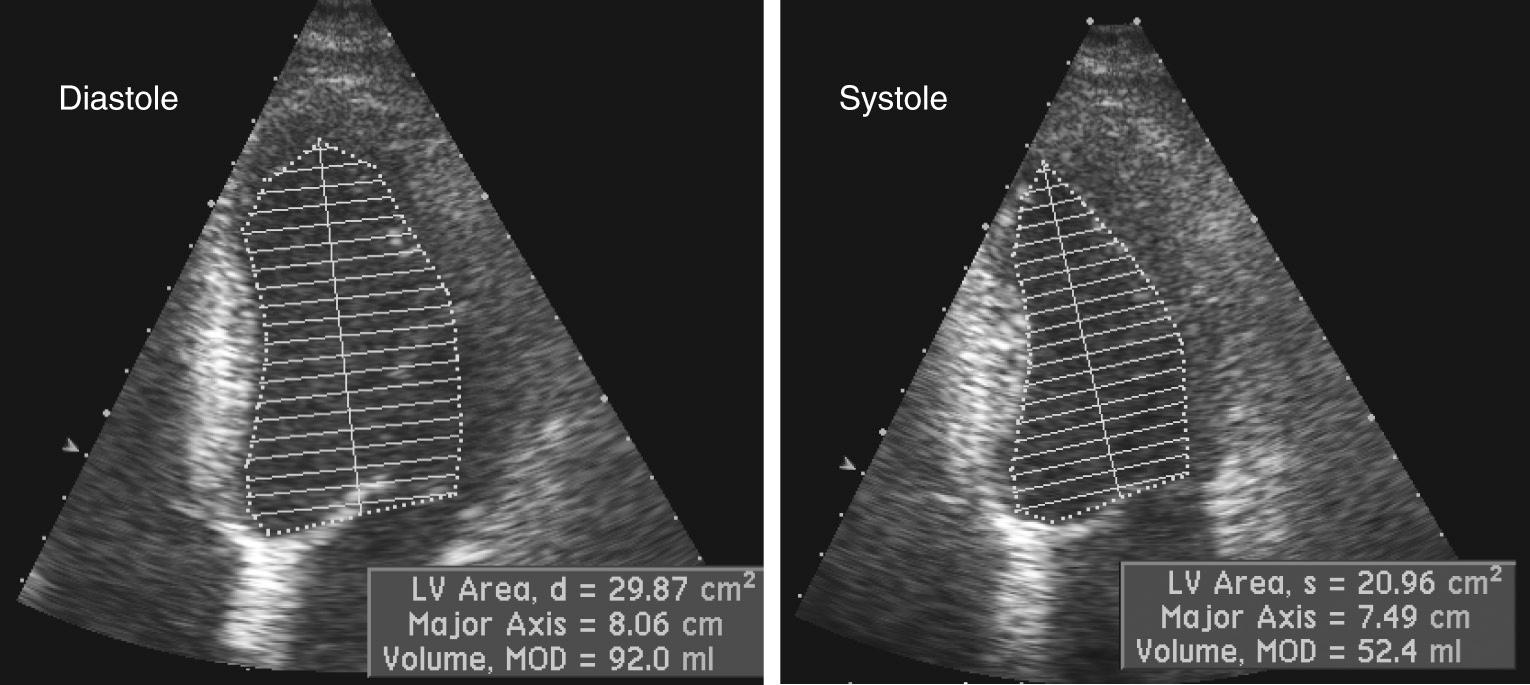
The most commonly applied algorithm is the biplane apical summation of discs method. Because the LV is assumed to be symmetric and bullet shaped to make this calculation, standard, nonoblique imaging planes are needed for optimal measurement. Rather than using geometric assumptions to estimate LV volumes, direct measurement of LV volumes is now possible with 3D imaging. With visualization of variability in the LV endocardial contour, 3D-derived LV volumes tend to be larger than 2D volumes ( Fig. 55-16 ). However, EF measurement accuracy relies on optimal endocardial definition, and image quality for 3D datasets remains relatively limited compared with 2D images. Therefore, 2D EF measurements remain the mainstay of LV systolic function assessment. A novel index of LV function, global longitudinal strain, uses computer algorithms which track natural acoustic markers in the myocardium ( Fig. 55-17 ). Global strain imaging is primarily used in research applications and is not yet commonly applied in standard imaging.
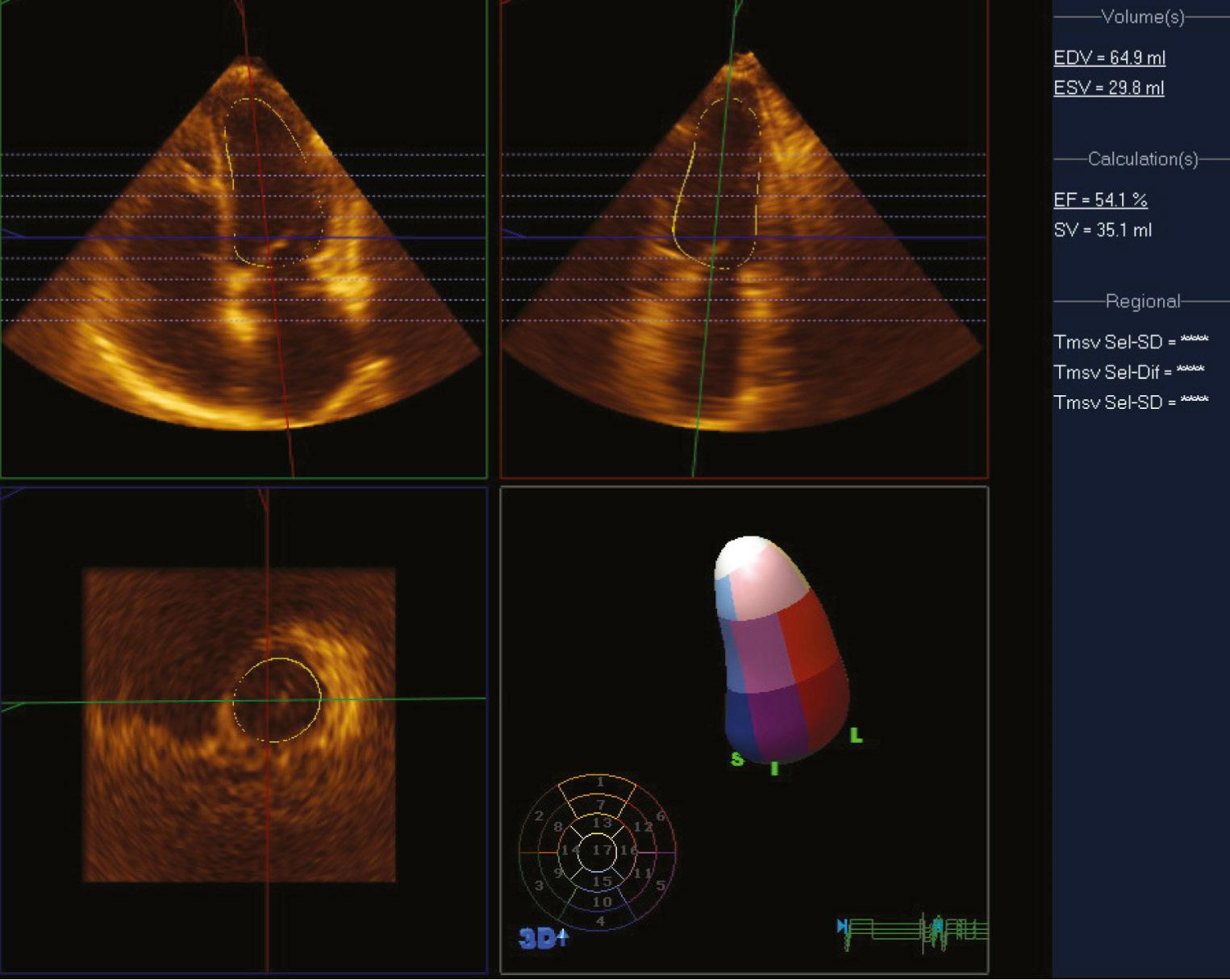
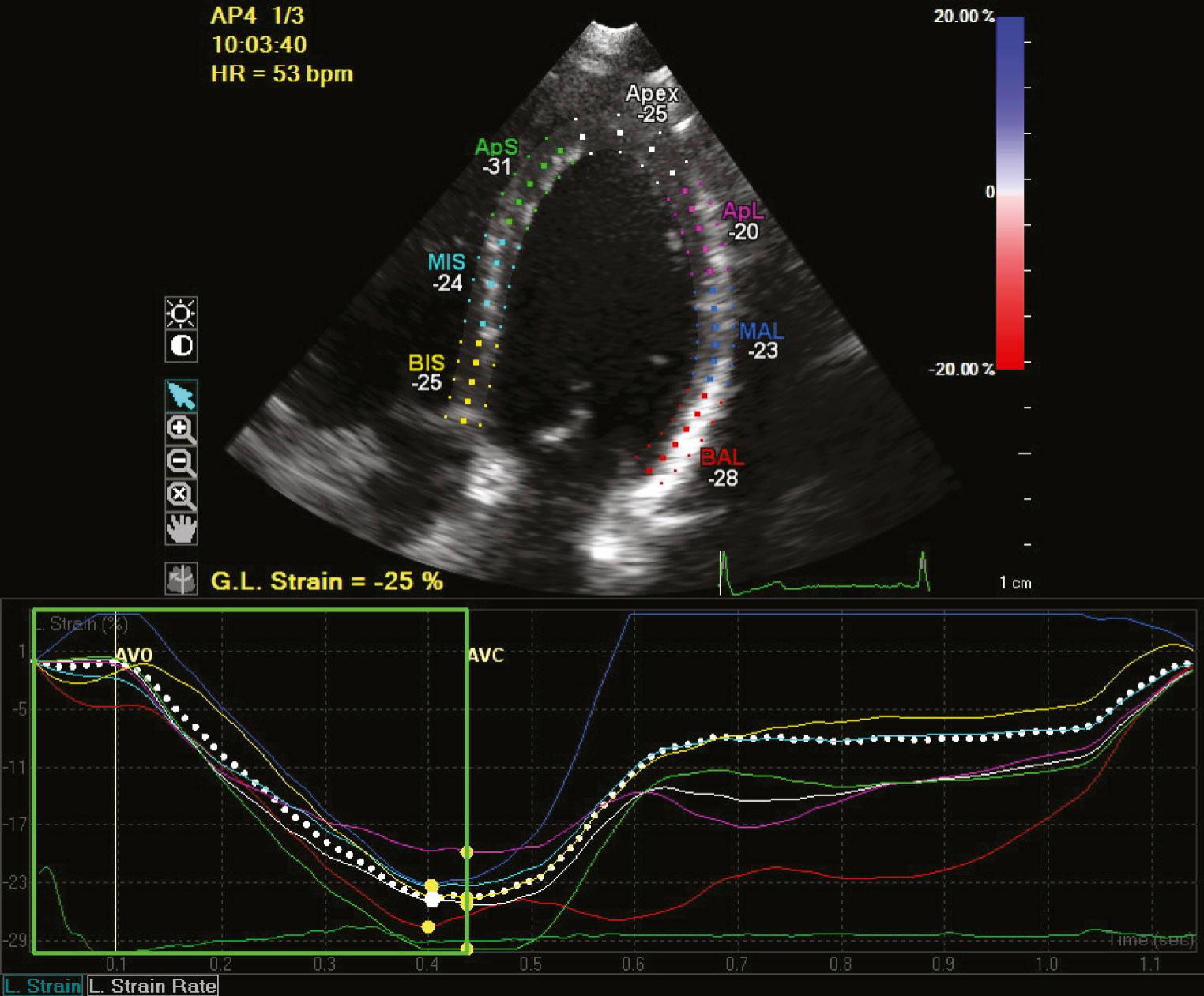
Echocardiographic assessment of systolic function is more challenging with segmental wall motion abnormalities and with arrhythmia, in which variability in cardiac cycle length affects beat-to-beat left ventricular volumes. Patients with conduction delay or who have previously undergone cardiac surgery may have dyssynchronous activation of the interventricular septum. When image quality precludes endocardial border tracing, qualitative assessment by an experienced echocardiographer is a reasonable alternative. Visual estimates of EF are usually reported in increment ranges of 5% or 10% (e.g., 50%-55% or 20%-30%).
A Doppler-derived measure of LV systolic function uses the early systolic rate of velocity increase in the mitral regurgitant jet, a relatively load-independent measure of contractility ( Fig. 55-18 ). The slope of the mitral regurgitant jet between two points on the velocity curve represents the rate of change in LV pressure over time (dP/dt). A normal dP/dt is greater than 1000 mm Hg/sec; a lower dP/dt slope is concordant with a delay in LV systolic pressure generation and depressed LV function.
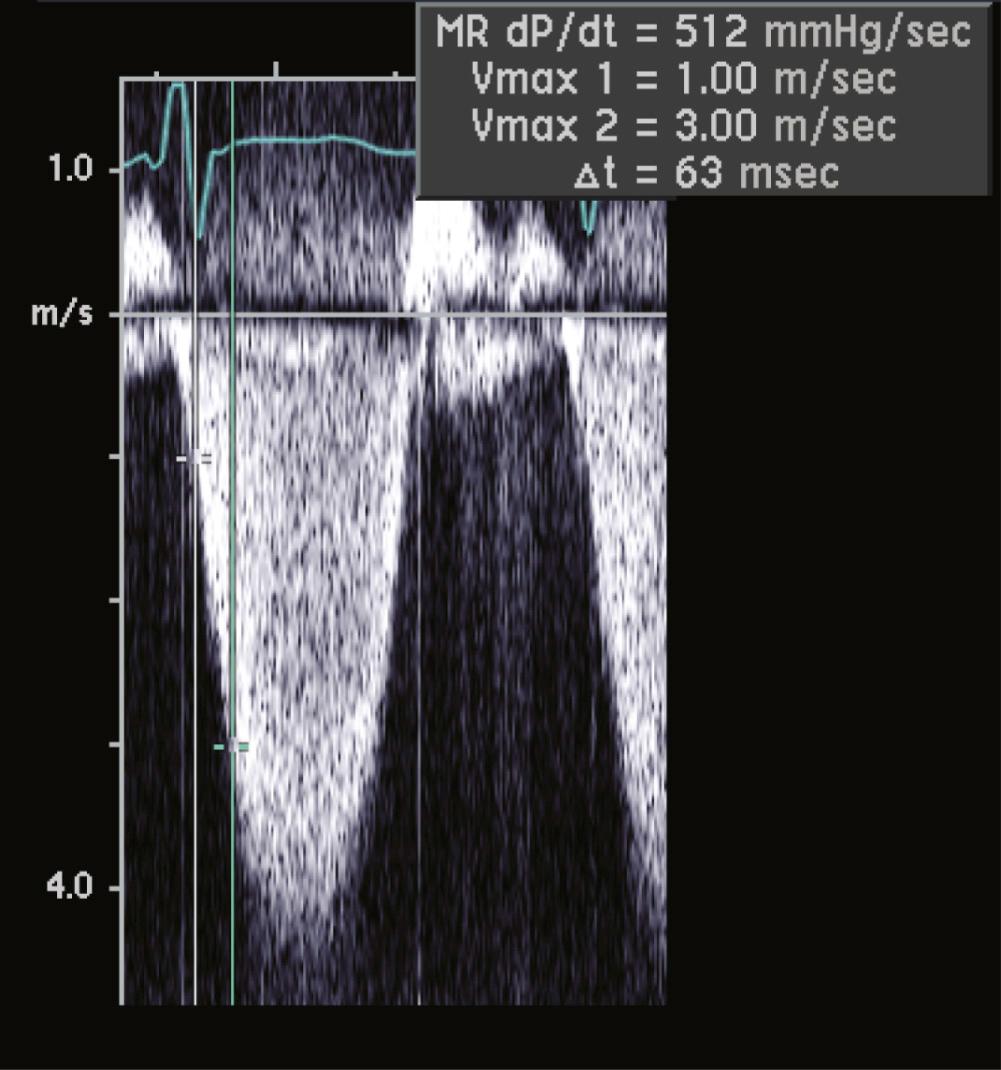
Right ventricular function is usually reported qualitatively on a scale of normal, mildly, moderately, or severely depressed. Multiple views of the right ventricle are often needed to provide a reasonable assessment of global systolic function. Semiquantitative measures of RV function are difficult because, as opposed to the LV, geometric assumptions of symmetry are not valid. The RV free wall “wraps” around the left ventricle, forming a crescent shaped chamber. The most commonly used measure is the tricuspid annular plane systolic excursion, a single-plane M-mode distance measurement for which greater than 1.8 cm suggests normal systolic function ( Fig. 55-19 ).
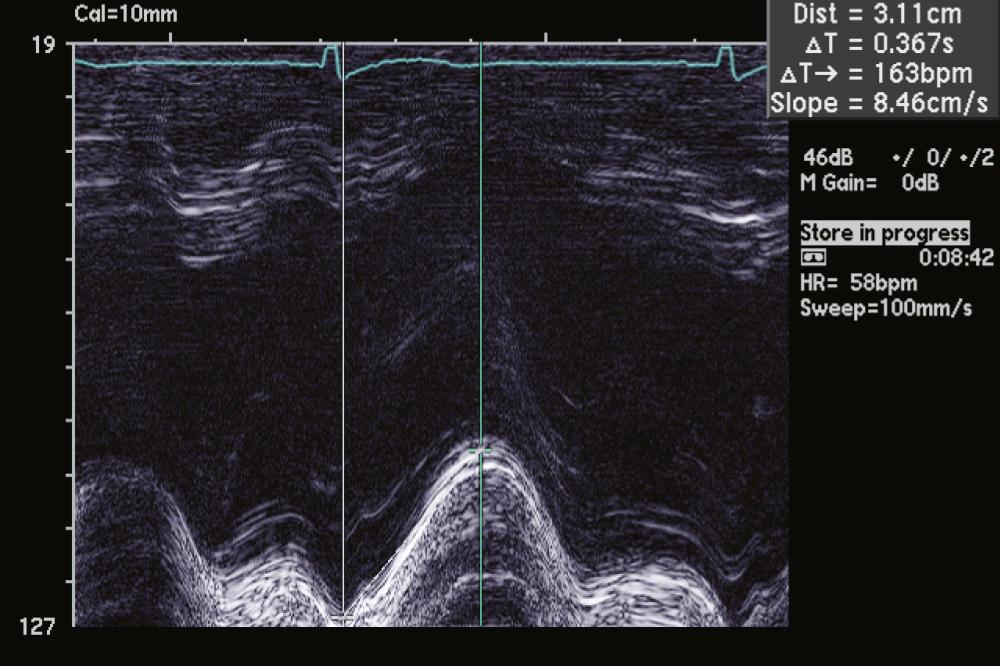
Diastole comprises four phases: (1) isovolumic relaxation, (2) atrioventricular valve opening with passive early rapid ventricular filling, (3) diastasis, or deceleration of passive LV filling owing to equalization of atrial and ventricular pressures, and (4) late active ventricular filling owing to atrial contraction. Several echocardiographic parameters are used to evaluate diastolic function. Increased left atrial size is a surrogate measure of increased left atrial (and LV end-diastolic) pressures. Pulse wave Doppler indices include the evaluation of LV inflow velocities with early “E” wave filling and the atrial contribution to filling (“A” wave). The “E” wave deceleration time (DT) and isovolumic relaxation time (IVRT) are measures of LV relaxation.
In normal, young individuals, early filling is the dominant component of LV filling with atrial contraction contributing less than 20% to total filling volume. Therefore, the E wave is higher with an E : A ratio greater than 1. With aging, ventricular stiffness increases, there is delay or impaired myocardial relaxation, and the relative contribution of atrial contraction is increased, with reversal of the E and A velocities and E : A ratio less than 1 ( Fig. 55-20 ). In advanced diastolic dysfunction, decreased LV compliance leads to rapid equalization of the transmitral diastolic pressure gradient. With increased LV end-diastolic pressure, atrial contribution to LV filling is small, manifesting as an E : A ratio greater than 2, a steep deceleration slope and shortened IVRT ( Fig. 55-21 ). Although patients in transition from an impaired relaxation pattern to a restrictive pattern have decreased LV compliance, the E : A ratio may appear normal, making interpretation of diastolic indices difficult. Loading conditions (heart rate, volume overload, mitral regurgitation) affect left atrial pressure and transmitral gradients. Mitral inflow evaluation repeated during a Valsalva maneuver (transient preload decrease) can unmask diastolic dysfunction, aiding in diagnosis.
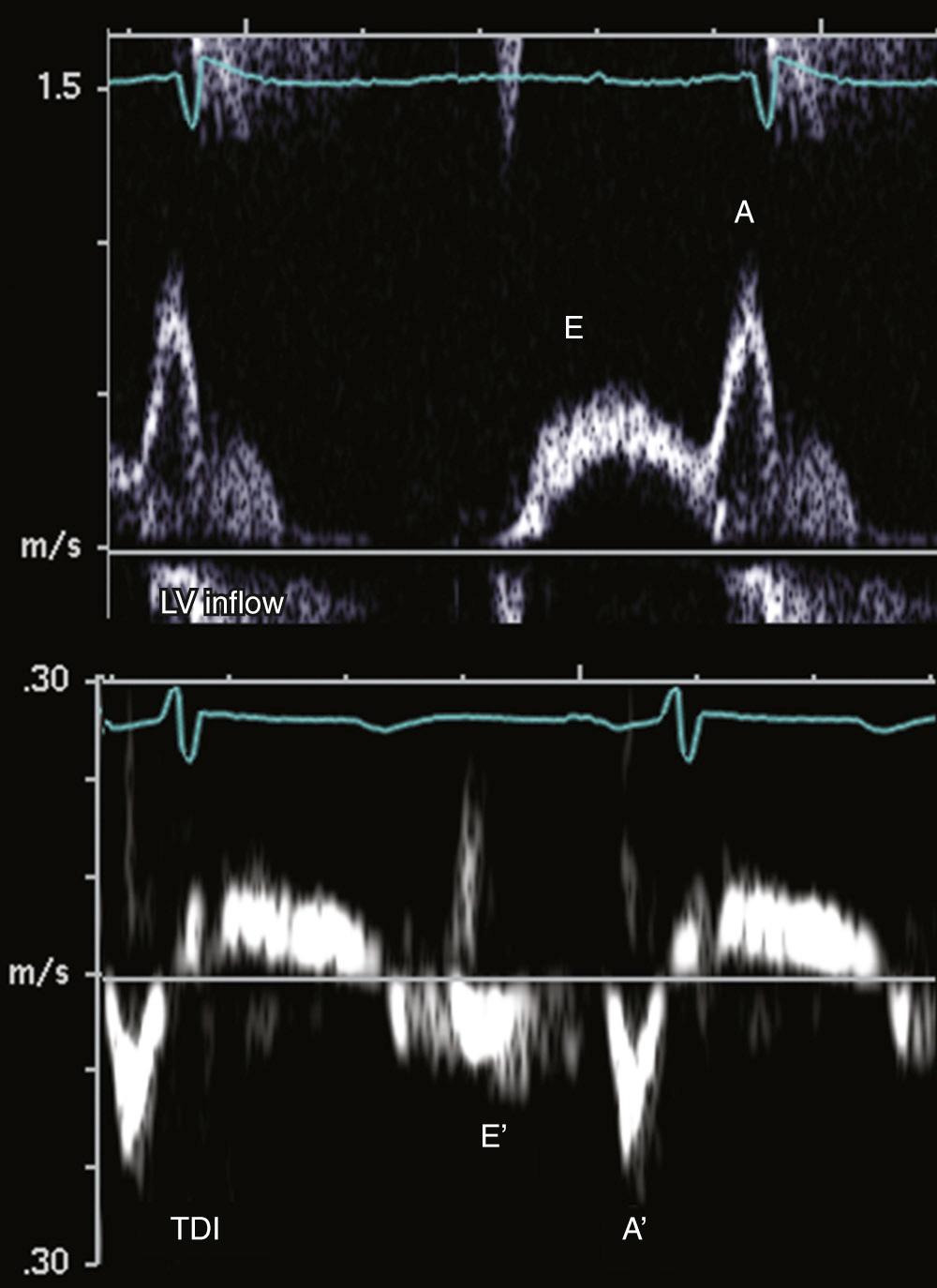
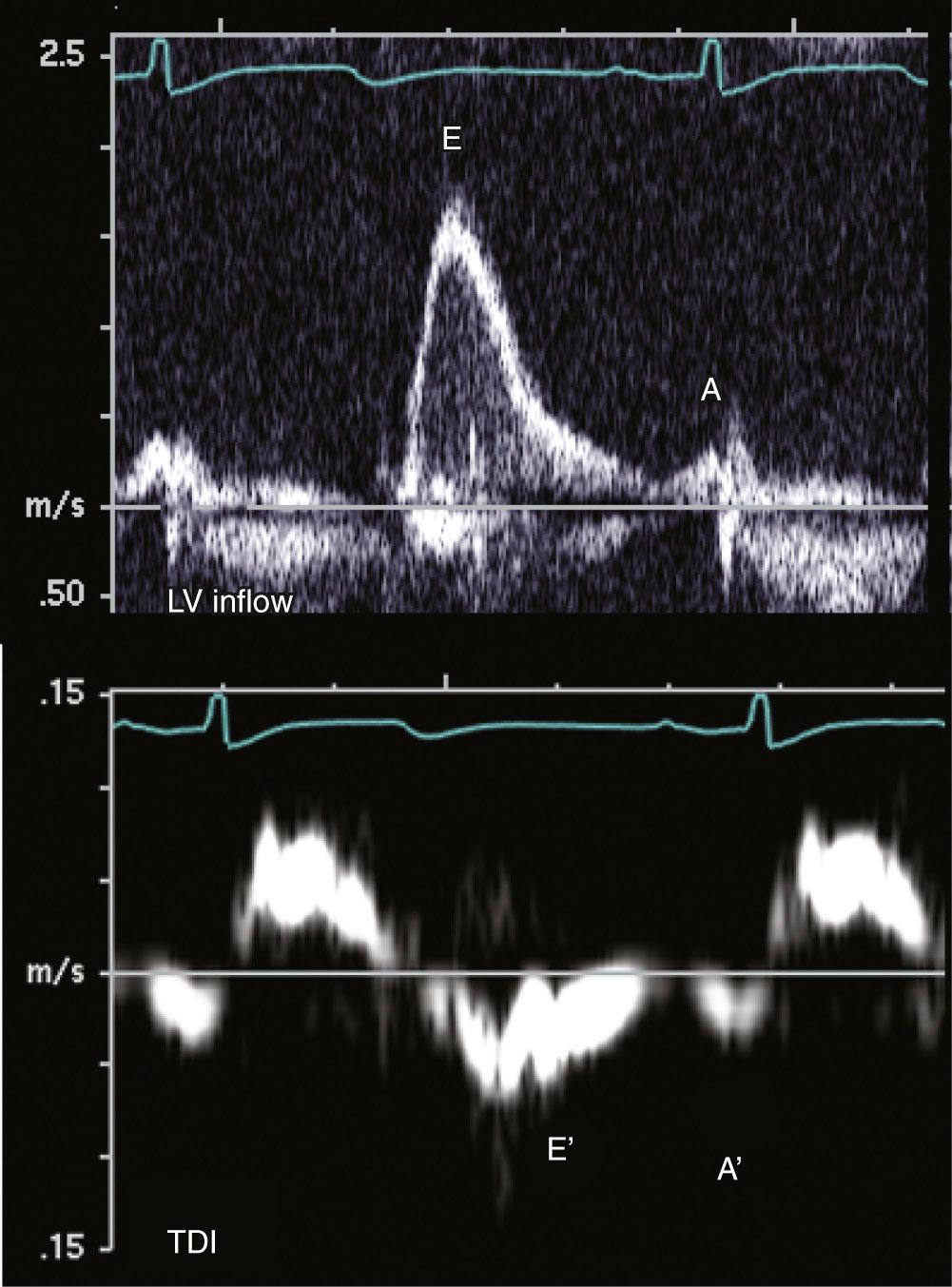
Tissue Doppler interrogation at the septum and lateral wall just below the mitral annulus allows evaluation of myocardial diastolic motion. Myocardial early (E') and atrial (A') waves correspond to mitral E and A waves and are less sensitive to atrial loading than mitral inflow (see Figs. 55-20 and 55-21 ). The transmitral E to myocardial E' (E:E') ratio is a strong surrogate measure of LV filling pressure, with a ratio less than 8 suggesting normal left atrial pressure and a ratio greater than 15 increased left atrial pressure. A ratio between 8 and 15 is indeterminate.
Abnormalities in diastolic indices can also be seen with extracardiac constraint of ventricular filling such as in constrictive pericarditis or tamponade. Normal RV filling demonstrates mild respiratory variation in transtricuspid velocities. On inspiration, there is an increase in systemic venous return and a transient increase in velocities, with normal magnitude increase less than 20%. Because left atrial filling is not respiratory dependent, transmitral velocities do not normally vary significantly with respiration. With pericardial tamponade and chronic pulmonary disease, exaggerated inspiratory-expiratory respiratory variation in the transtricuspid and transmitral velocities may be seen ( Fig. 55-22 ).
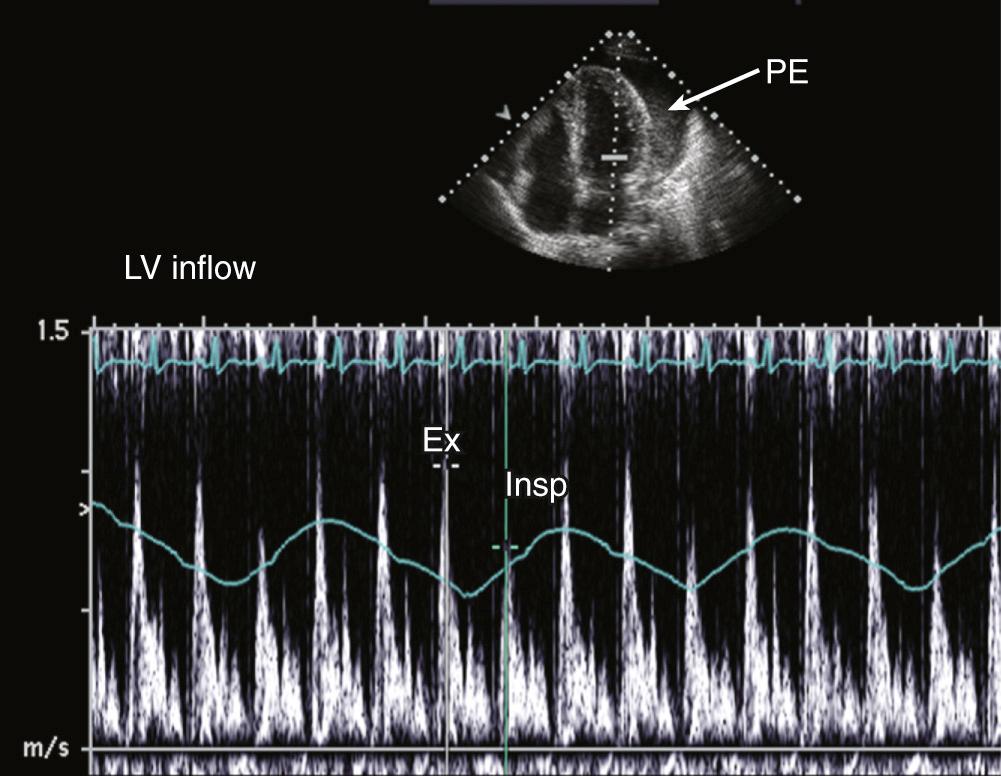
Direct visualization of coronary artery anatomy by echocardiography is rarely possible beyond visualization of coronary ostia. However, echocardiography is well suited to visualize effects of altered coronary perfusion on endocardial motion and wall thickening. With impaired coronary blood flow, segmental wall motion abnormalities are seen in affected myocardium. Myocardial responses to ischemia include hypokinesis (myocardial thickening with relatively less inward motion than the rest of the myocardium), akinesis (absence of thickening or inward motion), and dyskinesis (thinned and infracted myocardium with paradoxical outward systolic motion).
Myocardial response to ischemia is to the severity of ischemia, hypokinesis progressing to akinesis in more severe cases. Although acutely infarcted myocardium appears hypokinetic, wall thickness may be normal as postinfarct remodeling has not yet occurred. In patients with an acute, ST elevation infarction, myocardial segments subject to prolonged ischemia are likely to remain hypocontractile in the long term, whereas segments subjected to only a short duration of coronary flow limitation may return to a normal contractile state. Postinfarction myocardial dysfunction that subsequently returns to normal is termed stunned myocardium . Irreversibly infarcted regions appear thinned and akinetic with persistent akinetic or dyskinetic wall motion on long-term evaluation.
Echocardiography is useful in the detection of coronary disease in patients with chest pain symptoms. In patients with active chest discomfort, the absence of regional wall motion abnormalities on a resting study is an effective means of ruling out acute ischemia (negative predictive accuracy of ≈95%). In the operating room, intraoperative TEE allows for continuous monitoring of cardiac function and has been used during coronary revascularization and to monitor patients undergoing noncardiac surgery at high risk of cardiac events. TEE has also proven useful to evaluate cardiac function in the hemodynamically unstable patients in whom ischemia is suspected, but in whom transthoracic windows are suboptimal.
Takotsubo cardiomyopathy, or “stress cardiomyopathy,” is acute, cardiac syndrome characterized by chest pain or dyspnea following a significant emotional or physiologic stress. The echocardiographic manifestation is transient akinesis of the apical and mid-LV segments with regional wall motion abnormalities that extend beyond a single epicardial coronary arterial distribution. Angiography demonstrates the absence of obstructive coronary disease or acute plaque rupture. Outcome is generally good, and ventricular functional recovery is likely with supportive care.
Stress echocardiography is useful for initial diagnosis of coronary disease, monitoring disease progression in patients with known coronary lesions, and evaluating the functional significance of residual lesions following revascularization. Stress echocardiography provides visualization of myocardial function during active stress, allowing for diagnosis of myocardial ischemia in a controlled setting. Accuracy for stress echocardiography to determine extent and location of myocardial ischemia is excellent, and it is particularly useful when baseline electrocardiograph (ECG) abnormalities render standard exercise ECG testing nondiagnostic. The addition of imaging increases sensitivity and specificity over standard exercise ECG stress testing. Various exercise (treadmill or bicycle ergometer) and nonexercise cardiac stressors (dobutamine) are used. Echocardiographic images are acquired at rest and at peak stress. For treadmill protocols, images are acquired immediately after cessation of exercise because of imaging difficulties while the patient is upright on the treadmill. Images are integrated with ECG data, exercise tolerance, and patient symptoms for final interpretation. Using standard views of the LV, side-by-side comparison of the rest and stress digital images allow identification of wall motion abnormalities (see Fig. 55-8 ). Ischemia diagnosis is dependent on accurate evaluation of segmental wall motion and interval change from rest images. As a consequence, diagnosis of ischemia is more difficult in patients with preexisting coronary artery disease and resting segmental abnormalities. When endocardial definition is suboptimal, intravenous contrast agents can be used to opacify the LV cavity and aid in endocardial border definition. Results of stress echocardiography testing offer long-term prognostic information.
In the absence of significant coronary narrowing, the myocardial response to stress is augmentation of systolic function with hyperdynamic motion. Flow-limiting coronary lesions are associated with systolic dysfunction in the myocardial region distal to the lesion. In noninfarcted myocardium, systolic function is preserved if coronary blood flow is adequate to meet oxygen demand at rest. The ischemic effect on ventricular wall motion and thickening is proportional to the severity of impaired coronary blood flow. For intermediate range lesions (50%-60% stenosed) or single-vessel disease in which only a few myocardial segments are affected, ischemic abnormalities may be subtle or transient. With cessation of the stressor and restoration of adequate coronary flow, wall motion returns to normal. A submaximal stress test lowers test sensitivity because provocation of ischemia is dependent on reaching an adequate workload. Prolonged delay in obtaining stress images also lowers sensitivity because ischemia detection requires the abnormality to persist long enough for image recording.
Exercise stress echocardiography is performed following a standard symptom limited protocol to achieve as high a workload as possible. When testing cannot be performed because of physical limitation or when exercise response may be limited, pharmacologic stressors such as dobutamine are alternatives to exercise. Dobutamine is typically initiated at 10 mg/kg/min and is increased at 3-minute intervals to a maximum of 40 mg/kg/min. If target heart rate (85% of the patient's maximum predicted heart rate) is not achieved, atropine can be additionally administered. Dobutamine stress testing is commonly used to monitor for transplant vasculopathy in post-cardiac transplant patients, in whom denervated hearts might not allow the achievement of target heart rate with exercise protocols.
Become a Clinical Tree membership for Full access and enjoy Unlimited articles
If you are a member. Log in here